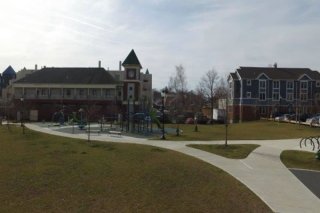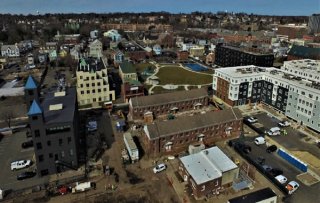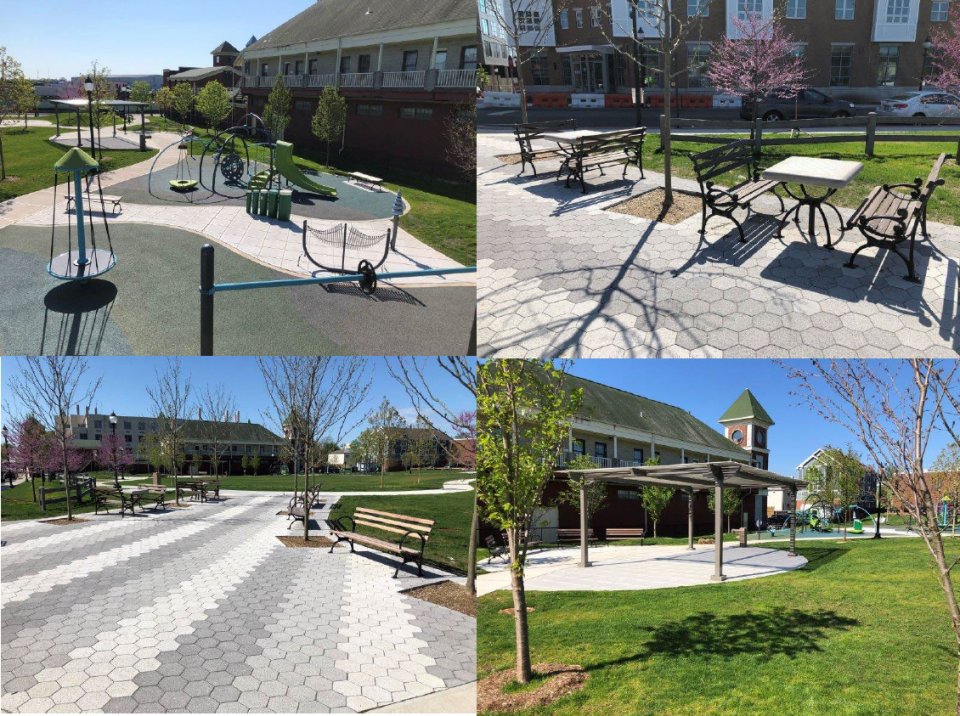R1 Success Story: Ryan Park, Norwalk, Conn.

(photo credit: Weston & Sampson)
EPA Grant Recipient:
Norwalk Redevelopment Agency
Grant Type:
Community-wide Assessment
Current Use:
Park and open space
Former Use:
Manufacturing Complex
Download Success Story:
Ryan Park Norwalk, Conn. (pdf)
A site once contaminated by the chemicals from a former manufacturing complex, Ryan Park is now host to walking paths and open space along the banks of the Norwalk River in South Norwalk, Conn., fondly referred to as SoNo by residents. This beautifully restored park is close to downtown Norwalk, a community settled in 1649 and now part of the New York metropolitan area. Historical maps indicate Ryan Park and the surrounding area were once mud flats and marsh lands associated with the nearby Norwalk Harbor until the area was filled and then developed sometime before 1884. A fur, dress, and hat manufacturing company previously resided on the site in 1922 along with other industrial occupants such as a rubber manufacturer, a machine shop, a chemical company, and a junk yard. By the 1950s, most of the large industrial buildings were demolished, and only residential and commercial properties remained. By 1991, all former site buildings were removed, and the public park was created. Flooding frequently plagued the area, however, with the most severe damage associated with Super Storm Sandy in October of 2012. The desire to revitalize and enhance SoNo was developed out of a vision created by residents, local businesses and elected officials through a 2012 HUD Choice Neighborhoods Initiative planning grant that focused on flood resiliency, improving the neighborhood, and meeting community needs.
Priming the Property for Redevelopment

(photo credit: Weston & Sampson)
The Norwalk Redevelopment Agency received an EPA community-wide assessment grant in 2014. The agency used $173,000 of this funding to assess the park as well as the city's 4.78-acre housing complex, Washington Village, the city's oldest housing complex, and to create a cleanup and reuse plan for the park. This plan included raising the elevation to provide dry egress for the neighborhood during storms. During the grant-funded sampling activities in 2016, polychlorinated biphenyls, volatile organic compounds, petroleum compounds, and metals were found to be prevalent at Ryan Park. As a result, the only recreational space in SoNo had to be closed in December of 2016 due to levels of PCBs above state standards. In March of 2017, a $2 million-dollar grant was awarded by the Connecticut Department of Economic and Community Development for cleanup work. By late 2018, the cleanup was completed by removing over 10,000 tons of contaminants and constructing a soil cap. During this cleanup, three underground storage tanks were unexpectedly discovered. Thanks to the Norwalk Redevelopment Agency's EPA funding, the tanks were assessed and removed without delaying the cleanup. By 2020, Ryan Park reopened to the public and was once again available to the community.
"Ryan Park, the primary open space in South Norwalk, needed active programming and improved amenities to increase the value of the park to the community. Frequent flooding would virtually eliminate the usability of the park and limit access to open space for local residents. With the generous support of the EPA, CT DECD, and HUD, the Norwalk Redevelopment Agency, in partnership with the City of Norwalk and Norwalk Housing Authority, has been able to transform this once-neglected park into a storm-resilient urban oasis."
Tami Strauss, Deputy Director
Norwalk Redevelopment Agency
Today

(photo credit: Weston & Sampson)
Ryan Park boasts renewed landscaping, ample lighting, two new playgrounds, an open field area, walking paths, a splash pad, basketball courts, a picnic/gathering area, an event pavilion, and a sculpture garden. The $200M redevelopment of Washington Village, now known as Soundview Landing, is now complete and includes 273 newly-constructed units with on-grade parking underneath the housing complex to raise the residences above the flood plain and provides mixed-income housing, including affordable, workforce, and market-rate units. The housing complex is within the Transit-Oriented Development District with access to public transit improving access to jobs and services. Thanks to the partnerships mentioned and a vision for a more sustainable city, Ryan Park and SoNo are a place for all to enjoy, further promoting community values and meeting its resiliency and neighborhood needs.

(photo credit: Weston & Sampson)
For more information:
Visit the EPA Brownfields website at www.epa.gov/brownfields or contact William Lariviere at 617-918-1231 or
Lariviere.William@epa.gov.
EPA 560-F-20-174
February 2025
